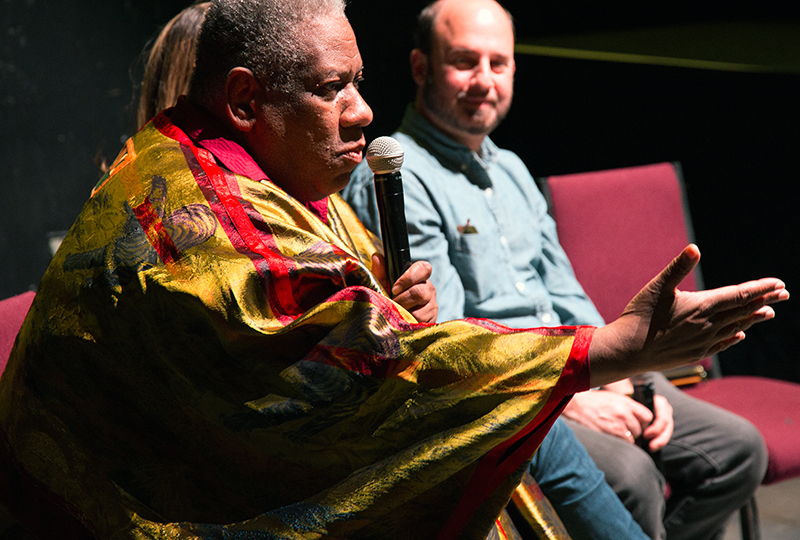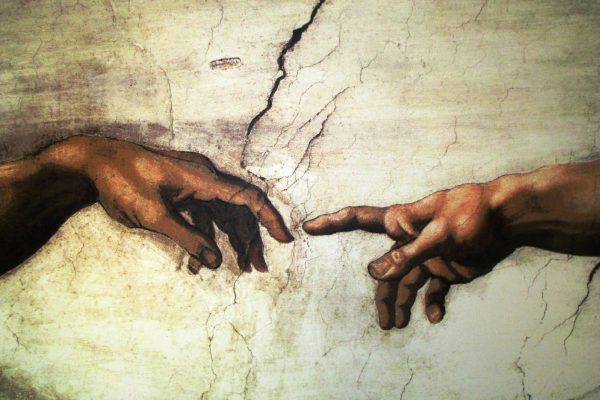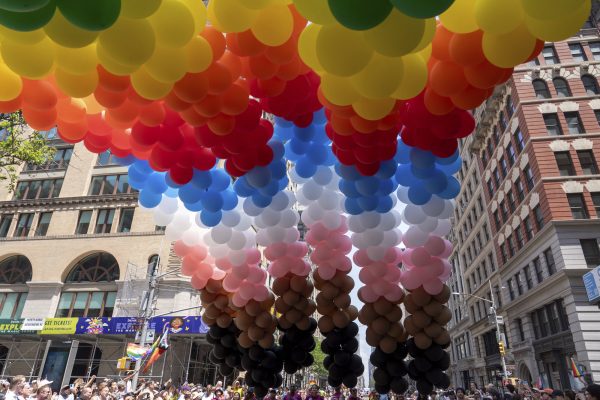The Chiffon Trenches: A Memoir
André Leon Talley
Ballantine Books, $28 (cloth)
Vanity Fair likely hoped that its July 2020 cover featuring Viola Davis would be a slam dunk of positive press and praise. It was photographed by Dario Calmese, the first black photographer ever to shoot a cover image for the magazine. The magazine’s editor-in-chief, Radhika Jones, had no doubt wanted to signal the dawn of a new day—as she put it, “captur[ing] the zeitgeist”—in seeing Black bodies. The cover, however, was no victory lap; instead it was perceived by many as yet another violence against Black bodies.
Few could argue that the image was not spectacular: Davis was dramatically shot, in profile, her Afro resplendently obscuring the magazine’s nameplate, her back partially revealed between the folds of an exquisite smalt-hued dress that plunged into a bow at her hips. But this pose, one that had been adopted for countless white subjects with little comment, had a very different resonance for audiences familiar with images of enslavement. And the connection was not left to the reader’s imagination: in Jones’s editor’s note for the issue, she wrote that the image is Calmese’s “re-creation of the Louis Agassiz slave portraits taken in the 1800s—the back, the welts. This image reclaims that narrative, transmuting the white gaze on Black suffering into the Black gaze of grace, elegance, and beauty.” But if audiences were meant to read the cover as a reclamation, all did not go according to plan.
Twitter and other social media erupted into anger, dismay, confusion, and disavowal of the portrait. The cover, to many, was simply the familiar and oppressive spectacle of Black pain, another example of the media selling—and instructing audiences to find pleasure in looking at—the Black body in pain. Couldn’t there surely have been a way to portray a successful Black actress at the height of her power that didn’t harken back to enslavement? Or is the zeitgeist of the Black body now and forever disjointed, agonizing, and exposed? When can the Black body simply and plainly be about beauty, desire, and joy?
These questions point to fundamental anxiety, distrust, and fear of the visual, a fear that is equally matched by profound desire for a beautiful, blissful, and seen Blackness. These are the dueling tensions that animate André Leon Talley’s new memoir The Chiffon Trenches. I am a long-time fan of Talley, who served as Vogue’s creative editor in the 1980s and ’90s and then as editor-at-large from 1998 to 2013. I have been reading his articles since I was a teenager, thinking about New York City, about fashion, about what it might mean to be independent, sassy, grown-up, about what it might mean to be queer and to care deeply about looking and seeing and being seen. He told his readers, over and over, that it is worth the time and effort to watch everything closely. But he also told us that there was power in making yourself seen. In essays, interviews, and photo shoots, he promised that you could escape one version of you and make a new you. And this new you would be worth watching. You could be amazing. To be clear: I believed him.
There is still a bit of that instruction in this new work, but the overriding tone of the memoir is one of sadness and regret. Talley—who for much of his career was notably evasive about directly calling out racism in the fashion industry—makes plain the intense, deep-seated, perverse, and unrelenting racial violence heaped upon him during the course of his career. The book is a blow-by-blow account of Talley’s attempts to come to some kind of peace with a culture and an aesthetic world that at every turn denies Talley the most basic and fundamental kinds of equality and intimacies.
Most reviewers and the press have focused almost exclusively on the gossipy aspects of the memoir, especially its depiction of Talley’s fraught relationship with former boss and Vogue editor, Anna Wintour. In recent years, Talley has made little secret of the fact that he now sees Wintour, once his friend, as a scion—and guardian—of colonialism and white privilege. But he has heretofore offered few details about what ultimately led to his ouster from Vogue. On this count, he does finally serve tea in his memoir, to the obvious delight of the press.
But in fact what strikes me most is that the memoir contextualizes his relationship with Wintour as just one of dozens of manipulative, deeply cruel, and racially-driven pathological relationships that Talley was forced to rely upon in the name of crafting a career in the fashion industry, one of the last great patronage systems. That he is alive to tell this tale is amazing; that this memoir has not been widely understood as evidence of the genocidal brutality of white people seeking to own, co-opt, and be enriched by Black labor signals just how unwilling we are as a culture to see anti-Black violence even as it is graphically, explicitly, and agonizingly articulated.
This memoir also attests, in a perverse way, to just how skilled Talley, and countless other queer non-white people are at laboring under violent conditions to produce stunning visuals that communicate taste, art, beauty, class, and desire. Yet this perfected beauty becomes the very weapon that is used, time and time again, to deny that Black pain is real. It’s a lose-lose proposition. It’s as though the bow on Davis’s dress is a knot, binding her, Talley, and Black bodies to stories and visions that cannot be escaped.
If sadness is the dominant emotion in Talley’s new memoir, it is a markedly different kind of melancholia than was projected in the 2017 documentary The Gospel According to Talley. Talley was essentially given up as a child, left in the care of his grandmother, and visited only occasionally by a generous but distant father and a disapproving, cutting mother. This intimacy deprivation extends into Talley’s adult life, and in the film Talley laments his lack of a life partner, which he chalks up to having been too career focused, a missed opportunity.
The sadness of the film is perhaps in spite of the director’s best efforts. Whenever things get too dark, a joke or the voice of an admirer is edited in. Talley is sad—but aren’t we all sad? it seems to say. Who is loved enough and who doesn’t have regrets? Sadness becomes integral to the world-weary charm of the character of André Leon Talley that the film crafts. That Talley has seen it all. And to use the now cloying Hamilton reference, sacrifices had to be made to make it into “the room where it happens.” Like many great men, like many trailblazers and heroes, greatness comes at great sacrifice. Life is hard, but think of the people Talley has met and dressed! Think of the food he has eaten and the gossip he has in that head! Think of the moments of iconic fashion he has witnessed! Though the viewer may find herself haunted later by how many of the film’s shots are of Talley sitting alone, it is clear that the film frames this in terms of choices made, knowingly, by a profoundly self-contained Talley, and which were ultimately all worth it.
Not so in Talley’s memoir. The sadness isn’t charming, or cute, or saucy, or fleeting. It’s deep, it’s inherited, it’s learned, it’s pushed on him, and it’s inescapable. If he were to forget it, there is always a white person around to remind him of it. He speaks often of his signature caftans and his weight as armor, and such military metaphors abound in the book. In the introduction, he writes, “I am a huge galleon slowly sailing into harbor, broken from so many battles.” It’s important not to miss that this phrasing also evokes the ships that moved so many enslaved people across the Atlantic. It is an image that, in both its registers, attends to stolen labor and abused bodies. As he reminds the reader only a few paragraphs earlier, “A black man goes through life realizing, There but for the grace of God go I.” The fear of disappearing that Talley learned growing up in the Jim Crow South is written into each of the memoir’s bon mot. Sad is actually a good day; terror and abuse is every day.
That his abusers are most often petite white women is not lost on Talley. He writes defensively, “I’m not belittling myself to say my strength was in my ability to be beside a small, great, powerful white woman and encourage her vision.” This image of Black alienated labor often shades, in Talley’s hands, into an image of himself as a kind of legitimating or ornamental Blackness to the great women he supported. For example, Diana Vreeland, the twentieth century’s other great editor of Vogue, gave Talley his first real job in fashion. He describes her “hiring” him in this way: “‘Follow me,’ she said, and I did. We went into her office, where she sat down and wrote my name in large letters. ‘HELPER,’ she wrote underneath it, and handed the paper to me. ‘You will stay by my side night and day, until the show is finished!’” A couple pages later, he adds, “She must have loved the idea of my presence, the combination of my looks, tall and honey colored; my impeccable manners and grooming; and my blossoming unorthodox style.”
The effort by Vreeland to assert ownership, control, and mastery over Talley’s body is plainly ugly. Talley seems to want it to be a narrative of adoration of Vreeland: of her talent, of her self-possession, of her being a boss bitch. But the story slips Talley’s grasp: Vreeland’s talent and self-possession—the very essence of her boss bitchness—is too clearly about the power of her whiteness to make “helpers” and to dictate that a young Black man cater to her needs and wants. Worse still, Vreeland all but drops Talley when she’s done with him. She doesn’t get him another job, doesn’t promote him onto her staff, and even though Talley credits Vreeland with helping him get his next big break at Interview, it was, as far as the reader can tell, by no fault of her own.
Of his next boss, Andy Warhol, Talley writes: “Andy could be naughty. He could also be vicious, but never to me. From time to time he would put his pale white hands in my crotch (always in public, never in private).” But already Talley has seemingly accepted the commodification of his body, of his talent, and of his personhood. He is passed around then, literally, to other magazines, other designers, other fashion personalities. Talley is frank about the fact that he responds variously to these experiences, sometimes with pleasure and other times with pain. This hyperawareness of himself as simultaneously prized and devalued commodity is most encapsulated in how much time in the memoir Talley spends tabulating gifts he was given and gifts that he gave. Every gifted trip on the Concorde and humiliating self-funded seat in economy is detailed. Designer Karl Lagerfeld loved to give extravagant gifts of furniture or apartments, but then also cruelly took those gifts away to signal that he was about to freeze out people. Socialite Lee Radziwill, another of Talley’s grandes dames, is given several deeply thoughtful gifts by Talley, and he notes what she clearly kept, and those he knows she likely gave away. So much time is spent on gifting that it is almost a distraction, until one realizes that this commodity exchange is freighted not only racially but sexually.
That such relationships stand in the place of a fuller sexuality is poignant. Talley was sexually abused as a child, and the shame and lack of control he felt are, he explains, at the root of his inability to access the sexual cornucopia in which his career placed him. And this haunts him. With remarkable rawness, he writes about crushes he had, men he loved, bodies he desired, and intimacy that he craved. Gifts, commodities, and passing attention are the only intimacies that Talley seems to have received, earning them such emphasis in the book.
And therein lies the deep and upsetting paradox of this memoir. There is, it turns out, no there there in the culture of luxury, desire, and commodity that Talley both meaningfully shapes and is trapped in. Likewise, his considerable talents—finely tuned to edifying and replicating fashion, design, and commercial culture—are the very weapons that keep him from freedom and visibility. Once you start to look, such paradoxes are to be found throughout Talley’s life. Take even his signature Bermuda shorts, which he wore through the 1970s and ’80s, dressing them up and down, making them hip and funny, and bespoke to his style. They are also, literally, the uniform of the colonial oppressor, made to accommodate climates that were hot but also marking a refusal to change the fundamental codes of European fashion and dress. An aesthetic to delight and accommodate the oppressors.
That Vogue was the pinnacle of his career to now—and also that he was sacked from it for precisely the qualities that first made him such a crucial and fundamental voice there—is no fluke. As Elspeth H. Brown writes in Work! A Queer History of Modeling, Vogue has always been a brand that draws on the visibility and authority of queer and BIPOC artists and models, but it uses their talents fundamentally to “center capitalist heteronormativity.” Talley—with his sublime writing and encyclopedic knowledge of fashion, art, and design—was put to the service of a company that empowers, sustains, and nurtures the very agents of racism, exclusion, and disappearance he fights.
Toward the end of the book, and in what are clearly the last fraying moments of Talley’s relationship with Wintour, she invites him to watch her at a fitting. To be clear, a fitting is essentially the performance of watching a woman try on clothes. So, to be invited to a fitting is to be invited to be an audience. To be instructed to watch and look at a body. There is some power in this position, to be sure. But really, by the end, what the reader sees is that Talley is still forced to be the “HELPER” and instructed that no matter what abuse and what cruelties are delivered, his job is to stand by her side at all times. Is there a better metaphor for white fantasies of Black bodies?
One of Talley’s favorite fashion spreads that he produced was for Vanity Fair, featuring another Black woman in a couture dress. This one wasn’t the cover, but, in its own way, it spoke to the same questions the Calmese/Davis cover provokes audiences to ask.
Talley notes that he “never demanded representation and diversity of models; I finessed.” In 1996 his finesse was to feature supermodel Naomi Campbell vamping it up in faux-plantation scenes à la Gone with the Wind. White designers (including John Galliano, Gianfranco Ferré, and Manolo Blahnik) were then cast as enslaved characters, in service to Naomi’s Scarlett O’Hara. It was, for its moment, a radical role reversal, a way in which commodity commercial culture could be used to dissemble and remix itself in a way that was—in at least a certain limited sense—subversive.
This was, no doubt, the desire for the Calmese/Davis cover. There must be a way out of seeing Black bodies only in service of whiteness—indeed, that is arguably the animating concert of Talley’s book. There must be a way to beauty, and away from pain. Talley ends the memoir declaring “I always wanted love.” Indeed. Talley can’t quite see his way to it yet, but he’s still asking.








